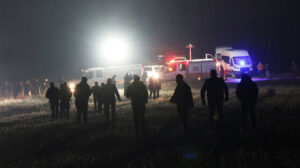Hospitals and the ambulance service are in full operational readiness to deal with the effects of the heatwave. Heatstroke, as well as other health problems due to very high temperatures, are common during heatwaves. So health authorities are on the alert to help citizens.
Last year in mid-July, when a heat wave lasted for several days, multiple cases of heatstroke were recorded, three deaths in Attica and one in Chalkida involving a 46-year-old delivery man. More specifically, over a period of five days (19-23/7), 116 people with symptoms of heatstroke needed to be taken to hospital by the ambulance service. In Attica, three people lost their lives, preceded by another fatal incident involving a worker in Chalkida.
Today and tomorrow, which will be the most difficult days due to the heatwave, according to meteorologists, ambulances and ambulance engines are available to respond in very little time to both heatstroke and drowning incidents, due to the accumulation of citizens on the beaches.
At its highest operational level, the CIP (Health Operations Centre) is also at its highest operational level, with four doctors instead of the three that normally coordinate hospitals. As far as public hospitals are concerned, there is no change in the operating schedule and on-call duty. But they, too, are on constant vigilance.
The imprint of extreme weather conditions on the health of citizens is profound. When the ambient temperature rises to levels that are intolerable for the human body in combination with other factors (humidity, apnoea, etc.), pathological conditions of varying severity are created.
The initial symptoms may be: severe headache, weakness, feeling of being overwhelmed, tendency to faint, drop in blood pressure, nausea, vomiting and palpitations.
Heatstroke: The dangerous symptoms and how to deal with them
Heatstroke syndrome, manifested by: sudden increase in body temperature ( >40.5 o C ), red, warm and dry skin (sweating has stopped), dry swollen tongue, palpitations, tachypnea, intense thirst, headache, nausea, vomiting, dizziness, confusion, inability to orient and clear speech, aggressive or strange behavior, convulsions, loss of consciousness or coma. According to ambulance rescuers, some incidents may not be directly related to the high temperatures, but may be due to the heat.
The World Health Organization (WHO) says that climate change will negatively affect the frequency and intensity of extreme weather events, including heat waves. A heatwave is defined as a period of unusually high temperatures and very low or very high relative humidity (depending on the region), lasting at least 2-3 days and having a significant impact on human activity and ecosystems, with no clearly defined start and end times.
According to the Ministry of Health, from high temperatures the following are most at risk:
elderly people,
babies and young children,
pregnant and nursing women,
people who are overweight or obese,
people who work or exercise intensively in hot environments,
people with chronic illnesses (cardiovascular disease, hypertension, diabetes mellitus, lung disease, kidney disease, liver disease, mental illness, dementia, alcoholism or drug abuse, etc.),
people with acute illness, such as infection with fever or gastroenteritis (diarrhoea and/or vomiting),
people who for purely medical reasons are taking medication for their chronic illnesses, e.g. diuretics, anticholinergics, psychotropic drugs, hormones (including insulin and anti-diabetic tablets). Particularly during the period of high ambient temperatures they should consult their doctor for possible dosage modification.
The basic guidelines of the to citizens for heatstroke are:
If you feel, after long exposure to a hot (and humid) environment, headache, high fever (above 41 to 42 degrees Celsius), tachycardia, discomfort, dizziness, nausea, vomiting, loss of consciousness or the skin becomes dry, hot and very red these are some of the symptoms of heatstroke (a large increase in the heat of the human body because its elimination is prevented due to the high and humid temperature of the environment).
Tax Returns: How to Submit Declarations from Wages and Pensions
Providing assistance
If you are faced with a case of heatstroke, the following should be done until a doctor arrives or the patient is taken to a hospital:
1/ The heat stroke victim should, without delay, be taken to a shady, cool and if possible ventilated place.
2/ He should lie on his back and all those who, out of curiosity or interest, prevent him from ventilation should be removed.
3/ To be supplied with air using any makeshift means (fans, cardboard, etc.).
4/ Remove heavy clothing, apply cold pads and wet the whole body with cold water.
5/ If the person with heat exhaustion is able to drink liquids at that moment, make use of this possibility.
Ask me anything
Explore related questions





